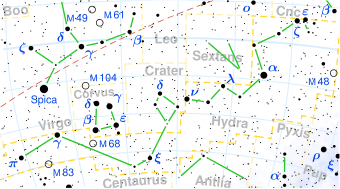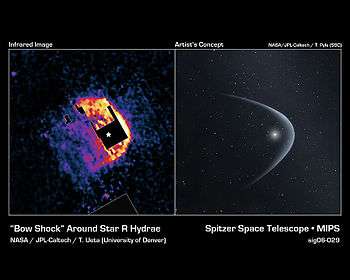R Hydrae

| |
| Observation data Epoch J2000 Equinox J2000 | |
|---|---|
| Constellation | Hydra |
| Right ascension | 13h 29m4 2.80s |
| Declination | -23° 16' 53.0" |
| Apparent magnitude (V) | 3.5 to 10.9 (variable)[1] |
| Characteristics | |
| Spectral type | M6e/M9e: |
| B−V color index | 1.3 |
| Variable type | Mira[1] (period 388.87 days) |
| Astrometry | |
| Radial velocity (Rv) | −10.4[2] km/s |
| Parallax (π) | 8.05 ± 0.69 mas |
| Distance | 410 ± 30 ly (120 ± 10 pc) |
| Details | |
| Mass | 2[3] M☉ |
| Radius | 460 (variable)[3] R☉ |
| Luminosity | 10,000 (variable)[3] L☉ |
| Temperature | 2,830[3] K |

The bow shock around R Hya [4]
R Hydrae, also known as R Hya,[1] is a Mira-type variable star in the constellation Hydra.[1][2]
The magnitude of R Hydrae varies over a period of 389 days, between 3.5 and 10.9. The period of R Hydrae changes slowly.
At maximum brightness the star can be seen with the naked eye, while at minimum a telescope of at least 5 cm is needed.
R Hydrae is approximately 400 light years from Earth. Its spectral class is M7IIIe.[2]
References
- 1 2 3 4 AAVSO
- 1 2 3 SIMBAD
- 1 2 3 4 Zijlstra, A. A.; Bedding, T. R.; Mattei, J. A. (2002). "The evolution of the Mira variable R Hydrae". Monthly Notices of the Royal Astronomical Society. 334 (3): 498. arXiv:astro-ph/0203328
 . Bibcode:2002MNRAS.334..498Z. doi:10.1046/j.1365-8711.2002.05467.x.
. Bibcode:2002MNRAS.334..498Z. doi:10.1046/j.1365-8711.2002.05467.x. - ↑ Spitzer Science Center Press Release: Red Giant Plunging Through Space
External links
This article is issued from Wikipedia - version of the 7/5/2016. The text is available under the Creative Commons Attribution/Share Alike but additional terms may apply for the media files.